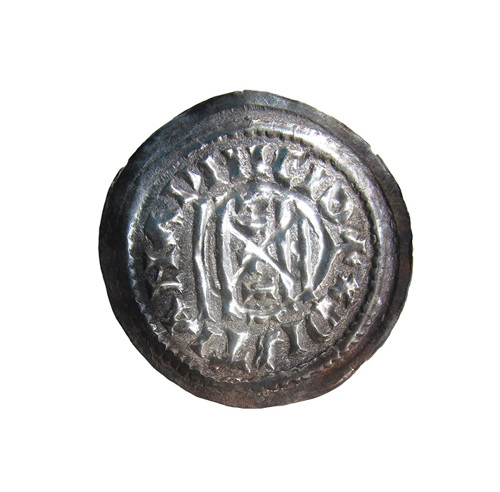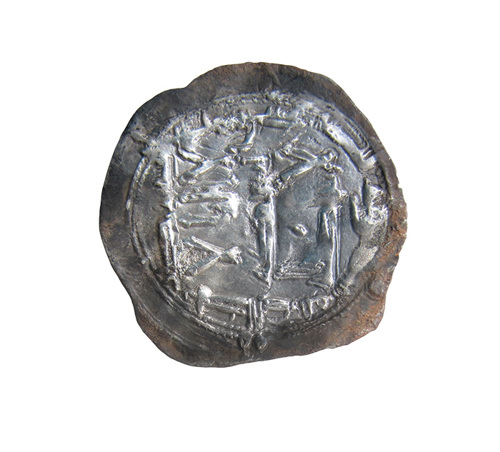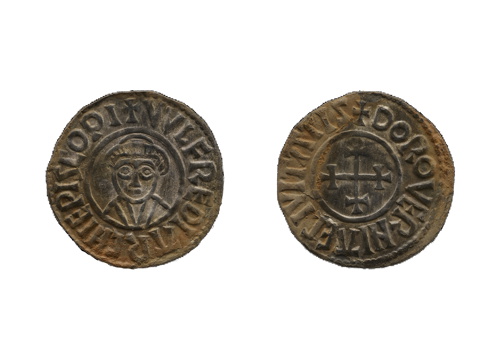Discover
The Herefordshire Hoard was buried around 878 AD. It includes 29 silver coins, a gold bracelet, a rock crystal pendant, and a silver ingot.
It is of great historical significance, shedding light on Viking activity and Anglo-Saxon alliances, particularly between King Alfred of Wessex and Ceolwulf II of Mercia. These items offer a rare glimpse into political and social dynamics during a pivotal era in English history.
Key Objects
Pendant
A rare 5th-7th century gold and crystal pendant, likely of Frankish workmanship. A flawless crystal sphere is encased in a gold openwork cage, adorned with herringbone-patterned strips and beaded wire. Found in Anglo-Saxon graves, it was possibly worn as an amulet.
HFDMG 2022-35/1

Finger Ring
A unique 9th-century Anglo-Saxon gold finger ring with an octagonal shape, featuring niello inlay. Each of the eight concave facets displays alternating rosette and pellet motifs in the Trewhiddle style, making it a rare example of its kind.
HFDMG 2022-35/2

Armlet
A large 9th-century Anglo-Saxon gold armlet with a stylized animal-head clasp, possibly a dragon. The faceted hoop and unique clasping method suggest a blend of Anglo-Saxon and Welsh influences. Decorated with five geometric facets, it’s a rare and sophisticated piece.
HFDMG 2022-35/3.

Ingot
A 9th-10th century silver ingot, likely used as bullion in Viking and Anglo-Scandinavian Britain. Weighing 59.65g, equivalent to over two Viking ounces or about 45 Anglo-Saxon silver pennies, it was used in trade or melted down for jewellery. Common in Viking hoards.
HFDMG 2022-35/4

Double Emperors
Rare silver pennies of Alfred of Wessex (871-99) and Ceolwulf II of Mercia (874-879), minted around 875-879. These "Two Emperors" type coins, featuring moneyers Dudell, Cimund, Dealing, and Eadwald, symbolise a political alliance between Wessex and Mercia in the late 9th century. Highly significant historically.
HFDMG 2022-35/18, 19, 28,29,30

Denier
A silver denier of Louis the Pious (814-40) or Louis II (855-875), minted in northern Italy, possibly Milan. Frankish coins like this are rare as single finds in Britain but common in Viking hoards of the late 9th and early 10th centuries. It features the inscription "CHRISTIANA RELIGIO."
HFDMG 2022-35/31

Dirham
A silver dirham of Abd al-Rahman II, minted in al-Andalus in 223 AH (840/1 AD). Double-struck, it is one of only two known in Britain, with the other found in the Cuerdale hoard. Likely current during the Andalusian raids of the 840s.
HFDMG 2022-35/32

Coin of Wulfred of Canterbury
A silver penny of Archbishop Wulfred of Canterbury (805-832), minted in Canterbury between 805 and 810. This two-line type coin follows the Cross-and-Lozenge and Two Emperors types, likely minted by the moneyer Wulfred.
HFDMG 2022-35/33

Research and discoveries
This section highlights the ongoing research taking place on the collection.
Understanding Anglo-Saxon History
Gareth Williams, the British Museum’s Curator of Anglo-Saxon coins, has been researching how the hoard changes our understanding of early English history. His work is reshaping what we know about Anglo-Saxon England, revealing new connections between England and the wider world— highlighted by the discovery of an Islamic Dirham among the hoard’s objects, showing far-reaching cultural and trade links.
Sampling Silver from the Hoard:
Experts from the University of Oxford's School of Archaeology conducted tests on a silver coin and ingot from the hoard, providing insight into the hoard's composition and origins.
Coin Examination
The detailed study of the hoard’s coins revealed rare pieces, such as the "Two Emperors" coins, which symbolize a surprising alliance between Alfred the Great and Ceolwulf II. These findings provide new insights into the political relationships of Anglo-Saxon England.
